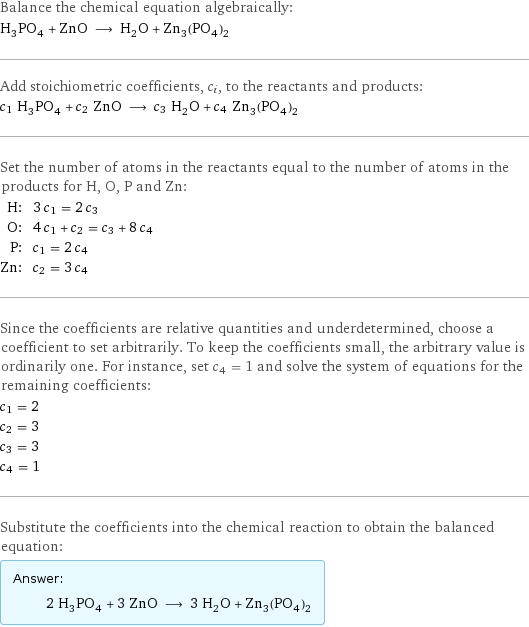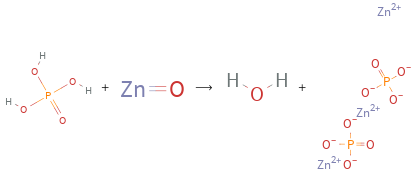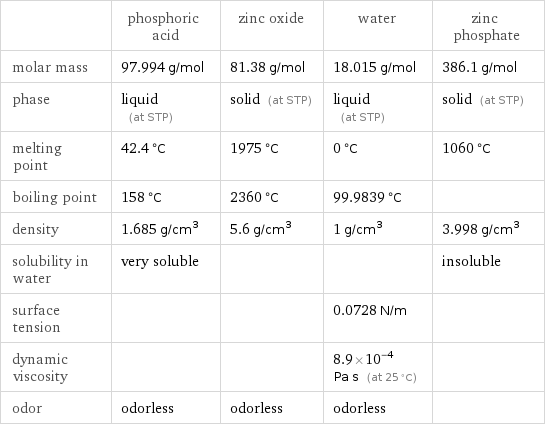Input interpretation

H_3PO_4 phosphoric acid + ZnO zinc oxide ⟶ H_2O water + Zn_3(PO_4)_2 zinc phosphate
Balanced equation

Balance the chemical equation algebraically: H_3PO_4 + ZnO ⟶ H_2O + Zn_3(PO_4)_2 Add stoichiometric coefficients, c_i, to the reactants and products: c_1 H_3PO_4 + c_2 ZnO ⟶ c_3 H_2O + c_4 Zn_3(PO_4)_2 Set the number of atoms in the reactants equal to the number of atoms in the products for H, O, P and Zn: H: | 3 c_1 = 2 c_3 O: | 4 c_1 + c_2 = c_3 + 8 c_4 P: | c_1 = 2 c_4 Zn: | c_2 = 3 c_4 Since the coefficients are relative quantities and underdetermined, choose a coefficient to set arbitrarily. To keep the coefficients small, the arbitrary value is ordinarily one. For instance, set c_4 = 1 and solve the system of equations for the remaining coefficients: c_1 = 2 c_2 = 3 c_3 = 3 c_4 = 1 Substitute the coefficients into the chemical reaction to obtain the balanced equation: Answer: | | 2 H_3PO_4 + 3 ZnO ⟶ 3 H_2O + Zn_3(PO_4)_2
Structures

+ ⟶ +
Names

phosphoric acid + zinc oxide ⟶ water + zinc phosphate
Equilibrium constant
![Construct the equilibrium constant, K, expression for: H_3PO_4 + ZnO ⟶ H_2O + Zn_3(PO_4)_2 Plan: • Balance the chemical equation. • Determine the stoichiometric numbers. • Assemble the activity expression for each chemical species. • Use the activity expressions to build the equilibrium constant expression. Write the balanced chemical equation: 2 H_3PO_4 + 3 ZnO ⟶ 3 H_2O + Zn_3(PO_4)_2 Assign stoichiometric numbers, ν_i, using the stoichiometric coefficients, c_i, from the balanced chemical equation in the following manner: ν_i = -c_i for reactants and ν_i = c_i for products: chemical species | c_i | ν_i H_3PO_4 | 2 | -2 ZnO | 3 | -3 H_2O | 3 | 3 Zn_3(PO_4)_2 | 1 | 1 Assemble the activity expressions accounting for the state of matter and ν_i: chemical species | c_i | ν_i | activity expression H_3PO_4 | 2 | -2 | ([H3PO4])^(-2) ZnO | 3 | -3 | ([ZnO])^(-3) H_2O | 3 | 3 | ([H2O])^3 Zn_3(PO_4)_2 | 1 | 1 | [Zn3(PO4)2] The equilibrium constant symbol in the concentration basis is: K_c Mulitply the activity expressions to arrive at the K_c expression: Answer: | | K_c = ([H3PO4])^(-2) ([ZnO])^(-3) ([H2O])^3 [Zn3(PO4)2] = (([H2O])^3 [Zn3(PO4)2])/(([H3PO4])^2 ([ZnO])^3)](../image_source/9ea106042742476773589863e6effc8b.png)
Construct the equilibrium constant, K, expression for: H_3PO_4 + ZnO ⟶ H_2O + Zn_3(PO_4)_2 Plan: • Balance the chemical equation. • Determine the stoichiometric numbers. • Assemble the activity expression for each chemical species. • Use the activity expressions to build the equilibrium constant expression. Write the balanced chemical equation: 2 H_3PO_4 + 3 ZnO ⟶ 3 H_2O + Zn_3(PO_4)_2 Assign stoichiometric numbers, ν_i, using the stoichiometric coefficients, c_i, from the balanced chemical equation in the following manner: ν_i = -c_i for reactants and ν_i = c_i for products: chemical species | c_i | ν_i H_3PO_4 | 2 | -2 ZnO | 3 | -3 H_2O | 3 | 3 Zn_3(PO_4)_2 | 1 | 1 Assemble the activity expressions accounting for the state of matter and ν_i: chemical species | c_i | ν_i | activity expression H_3PO_4 | 2 | -2 | ([H3PO4])^(-2) ZnO | 3 | -3 | ([ZnO])^(-3) H_2O | 3 | 3 | ([H2O])^3 Zn_3(PO_4)_2 | 1 | 1 | [Zn3(PO4)2] The equilibrium constant symbol in the concentration basis is: K_c Mulitply the activity expressions to arrive at the K_c expression: Answer: | | K_c = ([H3PO4])^(-2) ([ZnO])^(-3) ([H2O])^3 [Zn3(PO4)2] = (([H2O])^3 [Zn3(PO4)2])/(([H3PO4])^2 ([ZnO])^3)
Rate of reaction
![Construct the rate of reaction expression for: H_3PO_4 + ZnO ⟶ H_2O + Zn_3(PO_4)_2 Plan: • Balance the chemical equation. • Determine the stoichiometric numbers. • Assemble the rate term for each chemical species. • Write the rate of reaction expression. Write the balanced chemical equation: 2 H_3PO_4 + 3 ZnO ⟶ 3 H_2O + Zn_3(PO_4)_2 Assign stoichiometric numbers, ν_i, using the stoichiometric coefficients, c_i, from the balanced chemical equation in the following manner: ν_i = -c_i for reactants and ν_i = c_i for products: chemical species | c_i | ν_i H_3PO_4 | 2 | -2 ZnO | 3 | -3 H_2O | 3 | 3 Zn_3(PO_4)_2 | 1 | 1 The rate term for each chemical species, B_i, is 1/ν_i(Δ[B_i])/(Δt) where [B_i] is the amount concentration and t is time: chemical species | c_i | ν_i | rate term H_3PO_4 | 2 | -2 | -1/2 (Δ[H3PO4])/(Δt) ZnO | 3 | -3 | -1/3 (Δ[ZnO])/(Δt) H_2O | 3 | 3 | 1/3 (Δ[H2O])/(Δt) Zn_3(PO_4)_2 | 1 | 1 | (Δ[Zn3(PO4)2])/(Δt) (for infinitesimal rate of change, replace Δ with d) Set the rate terms equal to each other to arrive at the rate expression: Answer: | | rate = -1/2 (Δ[H3PO4])/(Δt) = -1/3 (Δ[ZnO])/(Δt) = 1/3 (Δ[H2O])/(Δt) = (Δ[Zn3(PO4)2])/(Δt) (assuming constant volume and no accumulation of intermediates or side products)](../image_source/a9cccb8af35ccbe47b2fe224433dd3f6.png)
Construct the rate of reaction expression for: H_3PO_4 + ZnO ⟶ H_2O + Zn_3(PO_4)_2 Plan: • Balance the chemical equation. • Determine the stoichiometric numbers. • Assemble the rate term for each chemical species. • Write the rate of reaction expression. Write the balanced chemical equation: 2 H_3PO_4 + 3 ZnO ⟶ 3 H_2O + Zn_3(PO_4)_2 Assign stoichiometric numbers, ν_i, using the stoichiometric coefficients, c_i, from the balanced chemical equation in the following manner: ν_i = -c_i for reactants and ν_i = c_i for products: chemical species | c_i | ν_i H_3PO_4 | 2 | -2 ZnO | 3 | -3 H_2O | 3 | 3 Zn_3(PO_4)_2 | 1 | 1 The rate term for each chemical species, B_i, is 1/ν_i(Δ[B_i])/(Δt) where [B_i] is the amount concentration and t is time: chemical species | c_i | ν_i | rate term H_3PO_4 | 2 | -2 | -1/2 (Δ[H3PO4])/(Δt) ZnO | 3 | -3 | -1/3 (Δ[ZnO])/(Δt) H_2O | 3 | 3 | 1/3 (Δ[H2O])/(Δt) Zn_3(PO_4)_2 | 1 | 1 | (Δ[Zn3(PO4)2])/(Δt) (for infinitesimal rate of change, replace Δ with d) Set the rate terms equal to each other to arrive at the rate expression: Answer: | | rate = -1/2 (Δ[H3PO4])/(Δt) = -1/3 (Δ[ZnO])/(Δt) = 1/3 (Δ[H2O])/(Δt) = (Δ[Zn3(PO4)2])/(Δt) (assuming constant volume and no accumulation of intermediates or side products)
Chemical names and formulas

| phosphoric acid | zinc oxide | water | zinc phosphate formula | H_3PO_4 | ZnO | H_2O | Zn_3(PO_4)_2 Hill formula | H_3O_4P | OZn | H_2O | O_8P_2Zn_3 name | phosphoric acid | zinc oxide | water | zinc phosphate IUPAC name | phosphoric acid | oxozinc | water | trizinc diphosphate
Substance properties

| phosphoric acid | zinc oxide | water | zinc phosphate molar mass | 97.994 g/mol | 81.38 g/mol | 18.015 g/mol | 386.1 g/mol phase | liquid (at STP) | solid (at STP) | liquid (at STP) | solid (at STP) melting point | 42.4 °C | 1975 °C | 0 °C | 1060 °C boiling point | 158 °C | 2360 °C | 99.9839 °C | density | 1.685 g/cm^3 | 5.6 g/cm^3 | 1 g/cm^3 | 3.998 g/cm^3 solubility in water | very soluble | | | insoluble surface tension | | | 0.0728 N/m | dynamic viscosity | | | 8.9×10^-4 Pa s (at 25 °C) | odor | odorless | odorless | odorless |
Units
